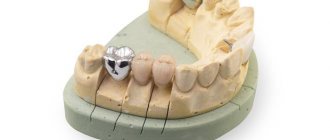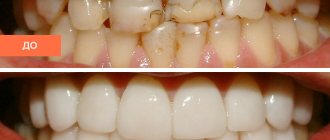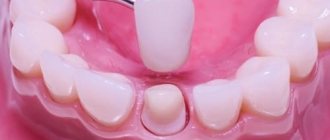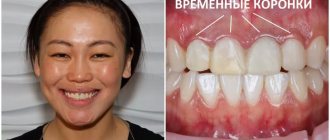Problem: Patients often come to Family Dentistry who want to fix a chip on a crown. Restoration is required for both metal-ceramic crowns and ceramic crowns.
Solution: at Dial-Dent, several dentists repair chips on crowns. It takes 1-1.5 hours for one tooth. Restoration of metal-ceramic crowns and ceramic crowns costs 7,100 rubles. Repairs are carried out without warranty, the reasons for this are discussed below.
Restoration of chipped crowns is needed to urgently restore the appearance of teeth. Chips on crowns often form after many years of use of artificial teeth, but they can also occur on new crowns if the dentist’s recommendations are not followed (it is not recommended to chew nuts or seeds, chew threads, wires, etc.). Chips on the front teeth are especially noticeable, even if the crown is entirely made of ceramic. For chipped front teeth, chip repair quickly restores aesthetics.
The most reliable solution is to replace the crown, but to replace the crown, you need to spend a lot of time and money, and this is often inconvenient at the moment. To delay the decision to replace a crown or bridge, it is much more convenient and cheaper for the patient to repair a chip on the crown.
Family Dental specialists carry out restoration of metal-ceramic crowns and ceramic crowns. The patient always receives a full report on the condition of the gums and crowns, alternative options are considered - changing the crowns or repairing them, how long each option will take and how much it will cost.
To repair chips on crowns, Dial-Dent uses materials from reliable well-known manufacturers and complies with all technological requirements for direct restorations (carried out directly in the patient’s mouth). This type of repair quickly restores aesthetics and function. No specialist or clinic can guarantee the service life of a chipped crown restoration, since too many factors influence whether the restoration will hold up or not. “Dial-Dent” guarantees that all technological requirements necessary for high-quality repair of a chipped metal-ceramic or ceramic crown will be met and proven materials will be used!
Description of material
A metal-ceramic crown is made from a metal alloy and then covered with porcelain. In this case, the frame can be made of several noble metals at the same time or simply of cobalt, nickel, chromium. It is these materials that provide the structure with the necessary strength, so the tooth and jaw as a whole can function normally. The ceramic layer is responsible for aesthetics.
Replacing teeth with ceramics is considered one of the most reliable and durable options. But, as a rule, they are the ones most often exposed to chips and various damages. Therefore, you need to know what to do if a piece of a metal-ceramic crown breaks off. The fact is that ignoring this problem can destroy it completely in a short time.
This is especially true for those people who do not follow medical recommendations and consume solid foods. Such abuse often violates the integrity of the tooth: first, microcracks form on it, and later chips appear.
Main causes of damage
A ceramic crown can become damaged for various reasons. But, as dental technicians note, the most common cases of chipping are as follows:
- A man has bruxism, and the dentist who performed the prosthetics did not ask about the disease.
- The patient does not comply with the operating instructions.
- The product may chip due to a foreign body that has entered the space between the tooth and the crown.
- When manufacturing the device, the master did not take into account the composition’s ability to thermally expand.
- There are too many dental units in the bridge, so it bears a heavy load of both external and internal nature.
- The shape of the prosthesis is incorrect or poorly made, so the pressure on it from the opposite jaw row is uneven.
- The technology during firing of the structure was violated.
- The preparation was not performed correctly, the taper of the crown is incomplete, which causes severe stress within the system.
- During the restoration, an excessively thick fixing cement mixture was used.
During the operation of the crown, a chip appeared
After the recovery procedure
Restoration of a metal-ceramic crown with damage of any complexity
Medical offers services for the restoration of dental crowns in a short time. We provide comprehensive treatment, dental prosthetics, and repairs at affordable prices. The individual approach and professionalism of the staff, the use of only high-quality materials and modern technologies allows you to achieve an ideal smile and the health of your teeth.
VTV managers will tell you about the cost of crown restoration and scheduling a visit to the clinic’s specialists in the feedback form on the website or by phone.
Modern methods of restoration
A chip in the ceramic mass does not look very attractive. The patient’s quality of life decreases and various complexes appear. Modern dentistry offers several ways to restore teeth; there are even options in which you can sharpen a metal-ceramic crown without removing it.
The most common restoration method is polishing. The procedure is performed for minor damage to the ceramic part of the tooth. The main disadvantage of this method is that the crown loses its original shape, so it is most often used if the chip is in an inconspicuous place.
One of the main advantages of polishing is accessibility, since the cost of such procedures is low. During the event, the doctor treats the damaged area with a special polishing compound using a rubber brush, and the gaps between the teeth with finishing plates.
Repairing a chip on a metal-ceramic crown involves completely replacing it. This option is the most expensive of all, but also the most reliable. If the structure was screwed in, then it is drilled out with a special drill and a suitable nozzle. If the crown was fixed with dental glue, then preliminary decementing is required: a softener is applied, which will bring the glue to a paste-like state.
After the structure has been cemented, the dentist makes a control impression, prepares the tooth, if necessary, and then performs processing. Next, the model is sent to the laboratory for the manufacture of a new product. The effectiveness of this method cannot be compared with any other correction option in terms of efficiency and effectiveness.
The next restoration is carried out only after the crown is removed, but it should immediately be noted that this option has many disadvantages, so doctors do not recommend using it. This is due to the fact that it is extremely difficult to maintain the integrity of a ceramic tooth if it is fixed with cement. Although there are patients who agree to this procedure because of the low cost and short repair time.
There are more progressive and gentle methods for restoring a chipped tooth that do not destroy ceramics. Such dental procedures involve the use of directional ultrasonic vibrations, as well as the supply of compressed air. But such procedures are carried out only in good clinics that are equipped with expensive devices.
Repairs can also be made directly in the oral cavity. As a rule, such restoration leaves virtually no traces behind. Modern composites are of very high quality; after spraying, the metal does not show through.
A significant disadvantage of the procedure: no doctor can guarantee that the crown will last a long time and will not fall off immediately. Such manipulations are somewhat reminiscent of ordinary fillings.
Recovery after removal
Restoring a ceramic prosthesis is quite difficult, and only a professional can do such work efficiently. The fact is that when removed, the crown may be damaged or completely destroyed, and it will be impossible to restore the product in order to glue it back. To carry out such events you will need tools and special devices:
- a device equipped with a tip that resembles a crochet hook;
- separator bolt;
- pneumatic hand tools;
- mechanical devices for removing the prosthesis from the mouth;
- spitting utensils;
- forceps.
The manipulations are carried out under local anesthesia, so the patient should not experience pain. Immediately after removal, the denture is sent to a special laboratory, where a dental technician will carefully examine the structure and restore the product. The entire recovery procedure usually lasts no longer than 3-5 hours.
It also happens
If a small chip has formed and the separated part is preserved, then it is simply glued to its original place using medical quick-drying glue. If the fragment is lost, then several ceramic layers are applied to the crown, thereby giving the tooth the required shape. After this, all that remains is to dry the prosthesis; this is done under the influence of high temperature in a special oven.
At the final stage, the technician grinds off excess fragments, grinds the crown and carries out final polishing. But this method is used extremely rarely, since the percentage of prosthesis removal without damage is extremely low. In addition, there is a high probability of injury to the gums and soft mucosal tissues. It is impossible to guarantee that such a design will last a long time, even if the work is done efficiently and professionally.
Oral repair
This option is most common among owners of metal-ceramic teeth. This is due to the fact that there is no need to remove the crowns; just open your mouth and the doctor will repair the damage on the spot. The procedure itself is performed in stages:
- Moisture is completely removed from the oral cavity. This is a prerequisite before any restorative procedures. The area where the chip formed is also thoroughly dried and then prepared with a diamond drill. This will make the tooth surface rougher, which will allow the composite to adhere to the ceramic more firmly and reliably.
- The surface is cleaned of any crumbs and diamond dust present on it. Next, the dentist impregnates the metal-ceramic crown and the area where there is damage with an acid mass for 1 minute. Modern clinics mainly use hydrofluoric acid for these purposes. After 60 seconds, the oral cavity is thoroughly rinsed under powerful water pressure and dried again.
- Then the doctor applies silane to the ceramic, which dries within a few seconds, and then treats the dental crown with a primer: this material enhances adhesion.
- After these steps are completed, the main work begins. Using a special composition, the required number of layers are applied to the chip site and the product is given the desired shape.
At the very end, the denture is treated with adhesive and then with a surface composite material. All that remains is to grind and polish the crown, and the procedure is considered complete.
Restoration of metal ceramics in the mouth
This option is the most popular. Performed in stages:
- The problem area is thoroughly dried;
- A diamond drill is used to roughen the surface for better adhesion of the ceramics to the composite;
- The surface is cleaned, impregnated with an acidic composition, washed and dried;
- Silane is applied to the chipped area, treated with a primer, and a special mass is applied in several layers until the desired shape is obtained;
- The resulting surface is treated with an adhesive and a finishing composite material;
- Sanded and polished.
From the outside, the crown will look perfect, but there is no guarantee of long-term use of the structure after such restoration. Currently, non-destructive methods for removing crowns with the least damage have been developed - ultrasound and compressed air. However, the experience and skill of the dentist is the guarantee that the prosthesis will be safely removed and will maintain its integrity for re-installation - and without the use of high technology.
Author:
Mayorov Andrey Mikhailovich
Specialization:
orthopedic dentistry, dental prosthetics, implant installation
Forecast of dental condition
It does not matter what technique was used to restore the metal-ceramic crown. It is impossible to predict exactly how long it will last. But you can determine the approximate service life based on several factors:
- Amount of damage. If the chip was large enough or there were several of them, then such dentures will collapse quite quickly, so it is best to initially replace the old structure with a new one.
- The basis. It is very important what the crown is made of: if it is metal, then the adhesion to the composite material will be several times lower than that of ceramic products.
- Malocclusion. This pathology can provoke a new breakdown almost immediately after restoration work.
- Non-compliance with operating rules and poor dental care.
- A bridge consists of a large number of dental units.
- A leaky connection causes the structure to quickly collapse.
As dentists note, the main cause of various damages is trauma and improper care of artificial teeth. If trouble does occur, restoration measures should be started immediately, otherwise the crown may completely collapse and a new product will be required.
Features of caring for metal-ceramic crowns
Repaired crowns must be properly cared for so that the fixed composite material lasts a long time and does not violate the integrity of the entire dentition.
Constantly clean your mouth and teeth in particular from plaque.
Many people believe that plaque does not accumulate on artificial teeth, so plaque can be removed less frequently. In fact, bacteria that collect on the surface of the tooth are primarily harmful to the gums. Causing inflammation, plaque can even cause destruction of the supporting tooth. You need to brush metal-ceramic teeth in the same way as natural ones. It is important to pay attention to the interdental passages - special flosses and brushes are used to care for them.
Visit your dentist regularly
Even if the attending physician has convinced you of the strength of the installed prostheses, it is extremely important to periodically sign up for a preventive examination. This will allow you to identify small chips and cracks early.
Give up bad habits
But even the most attentive patient can harm his metal-ceramic dentures if he continues to adhere to his bad habits: chewing hard objects, his nails, cleaning nuts and seeds with his teeth, or opening bottle caps with them. It is strictly forbidden to clean out food debris from the crevices between teeth using forks or other sharp metal objects.
Dryers and crackers can also harm both repaired and new dentures. Try to consume dry and solid foods as little as possible.
Follow all doctor's recommendations
In cases where a bridge is installed, the doctor prescribes washing the prosthesis and gums using a special irrigator or superfloss. It is necessary to use fluoride-containing toothpastes, applying them to the floss.
As a rule, metal-ceramic crowns become unusable precisely because of improper maintenance of the prosthesis. Listen to your doctor's recommendations and then you won't have to pay twice due to your own carelessness.











